Physiological and Exercise Testing: Strength, Power, and Performance
VerifiedAdded on 2021/04/21
|16
|3449
|39
Report
AI Summary
This report provides a comprehensive analysis of physiological and exercise testing, focusing on the assessment of strength, power, and sprinting performance. It begins by defining strength and power, highlighting their similarities and differences, and explores the factors that influence them, including age, gender, limb length, muscle fiber type, and tendon insertion points. The report then delves into the factors that influence explosive and sprinting performance, such as muscle fiber recruitment, rate coding, reaction time, and muscle stiffness. It then examines the rationale, strengths, and limitations of various assessment methods like 1RM, isokinetic force testing, Wingate sprints, and jump height. Furthermore, the report discusses the relationships between these measures and how this information can be used to guide training programs and predict sporting performance. Finally, the report concludes by emphasizing the importance of fitness tests being valid, reliable, sport-specific, and scientifically sensitive in order to effectively evaluate an athlete's capabilities and design appropriate training strategies. This report is a valuable resource for students and professionals in the field of exercise physiology and sports science.

Last Name 1
Physiological and Exercise Testing
By students Name
Professor
University Affiliate
City & State
Course
Date
Physiological and Exercise Testing
By students Name
Professor
University Affiliate
City & State
Course
Date
Paraphrase This Document
Need a fresh take? Get an instant paraphrase of this document with our AI Paraphraser
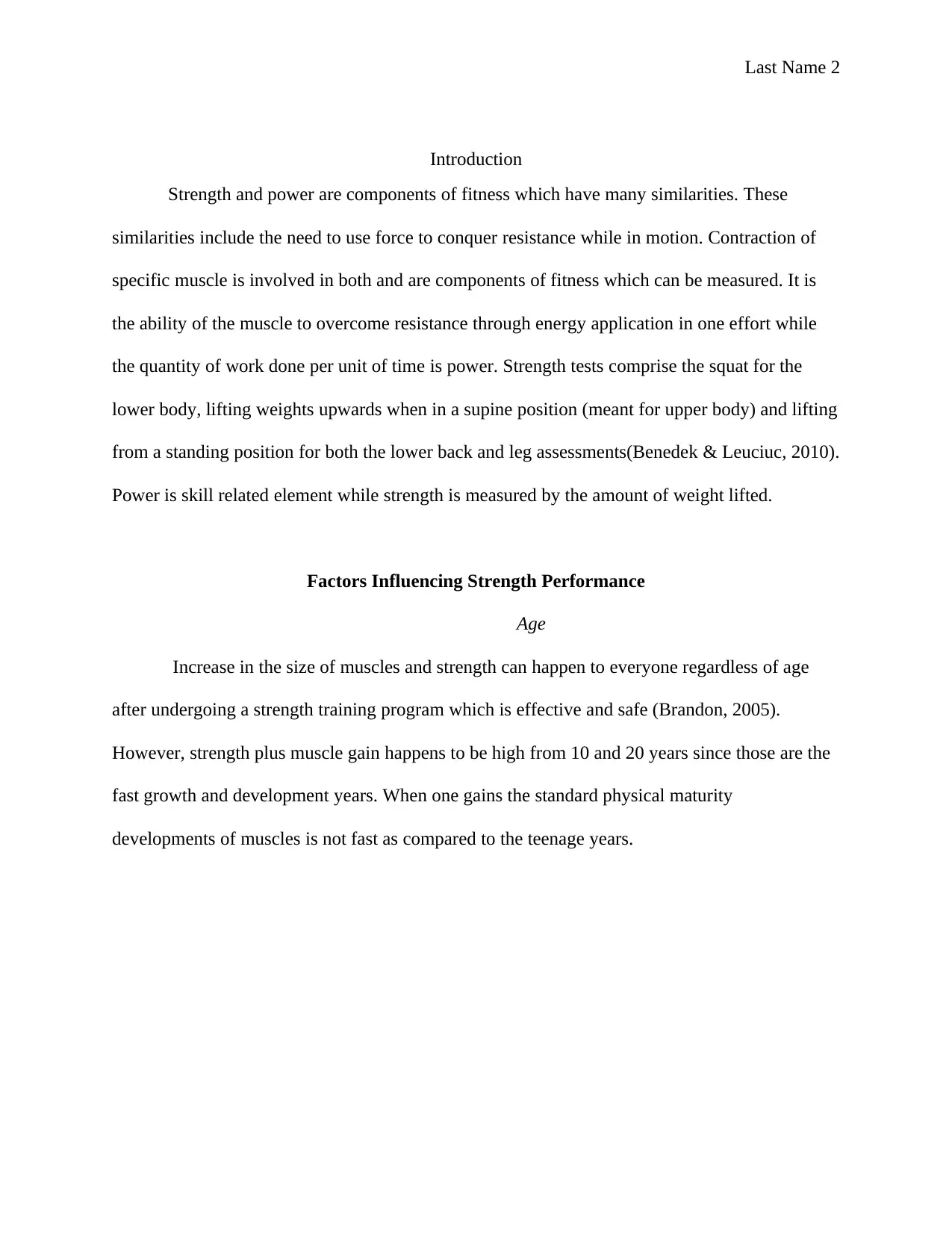
Last Name 2
Introduction
Strength and power are components of fitness which have many similarities. These
similarities include the need to use force to conquer resistance while in motion. Contraction of
specific muscle is involved in both and are components of fitness which can be measured. It is
the ability of the muscle to overcome resistance through energy application in one effort while
the quantity of work done per unit of time is power. Strength tests comprise the squat for the
lower body, lifting weights upwards when in a supine position (meant for upper body) and lifting
from a standing position for both the lower back and leg assessments(Benedek & Leuciuc, 2010).
Power is skill related element while strength is measured by the amount of weight lifted.
Factors Influencing Strength Performance
Age
Increase in the size of muscles and strength can happen to everyone regardless of age
after undergoing a strength training program which is effective and safe (Brandon, 2005).
However, strength plus muscle gain happens to be high from 10 and 20 years since those are the
fast growth and development years. When one gains the standard physical maturity
developments of muscles is not fast as compared to the teenage years.
Introduction
Strength and power are components of fitness which have many similarities. These
similarities include the need to use force to conquer resistance while in motion. Contraction of
specific muscle is involved in both and are components of fitness which can be measured. It is
the ability of the muscle to overcome resistance through energy application in one effort while
the quantity of work done per unit of time is power. Strength tests comprise the squat for the
lower body, lifting weights upwards when in a supine position (meant for upper body) and lifting
from a standing position for both the lower back and leg assessments(Benedek & Leuciuc, 2010).
Power is skill related element while strength is measured by the amount of weight lifted.
Factors Influencing Strength Performance
Age
Increase in the size of muscles and strength can happen to everyone regardless of age
after undergoing a strength training program which is effective and safe (Brandon, 2005).
However, strength plus muscle gain happens to be high from 10 and 20 years since those are the
fast growth and development years. When one gains the standard physical maturity
developments of muscles is not fast as compared to the teenage years.
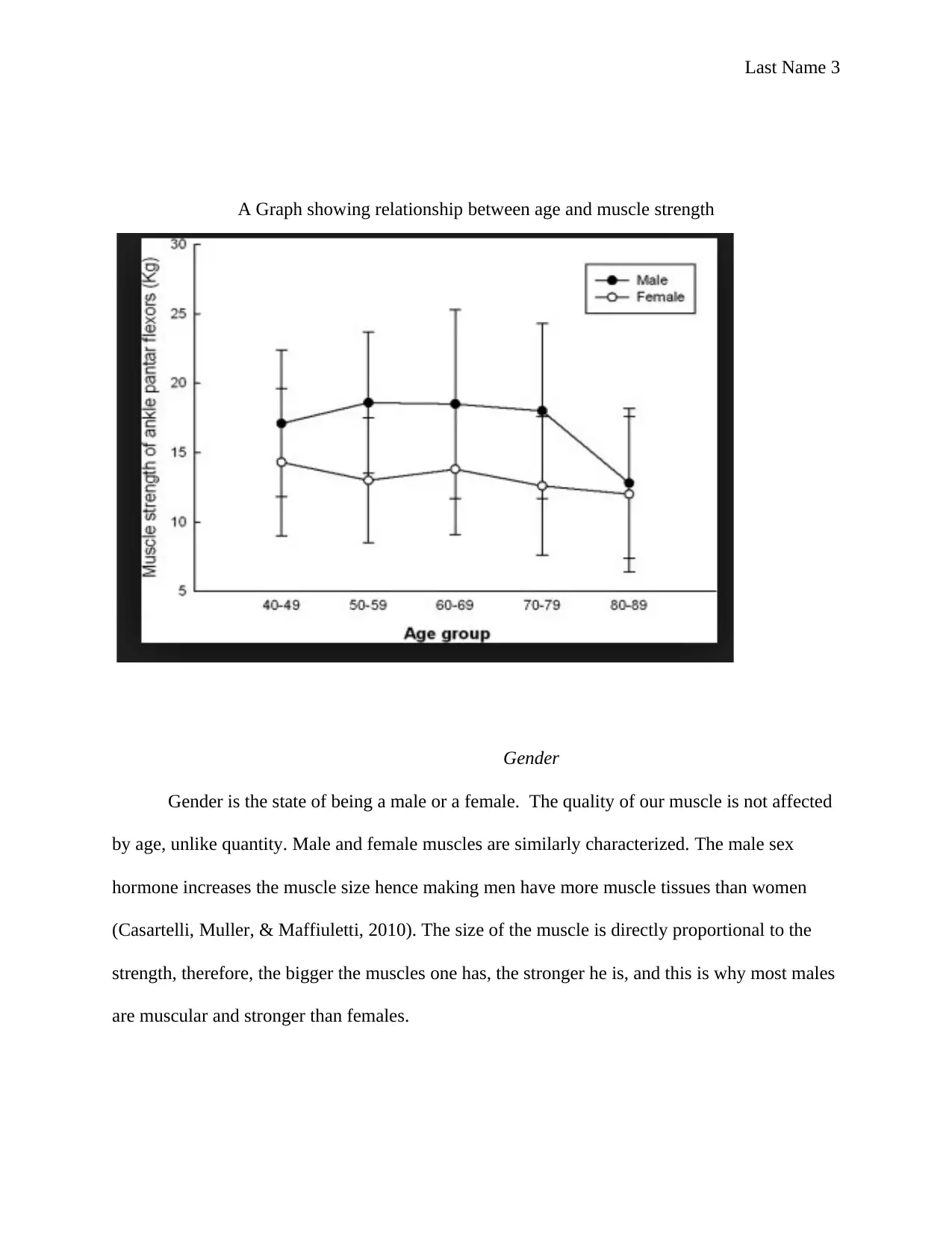
Last Name 3
A Graph showing relationship between age and muscle strength
Gender
Gender is the state of being a male or a female. The quality of our muscle is not affected
by age, unlike quantity. Male and female muscles are similarly characterized. The male sex
hormone increases the muscle size hence making men have more muscle tissues than women
(Casartelli, Muller, & Maffiuletti, 2010). The size of the muscle is directly proportional to the
strength, therefore, the bigger the muscles one has, the stronger he is, and this is why most males
are muscular and stronger than females.
A Graph showing relationship between age and muscle strength
Gender
Gender is the state of being a male or a female. The quality of our muscle is not affected
by age, unlike quantity. Male and female muscles are similarly characterized. The male sex
hormone increases the muscle size hence making men have more muscle tissues than women
(Casartelli, Muller, & Maffiuletti, 2010). The size of the muscle is directly proportional to the
strength, therefore, the bigger the muscles one has, the stronger he is, and this is why most males
are muscular and stronger than females.
⊘ This is a preview!⊘
Do you want full access?
Subscribe today to unlock all pages.

Trusted by 1+ million students worldwide
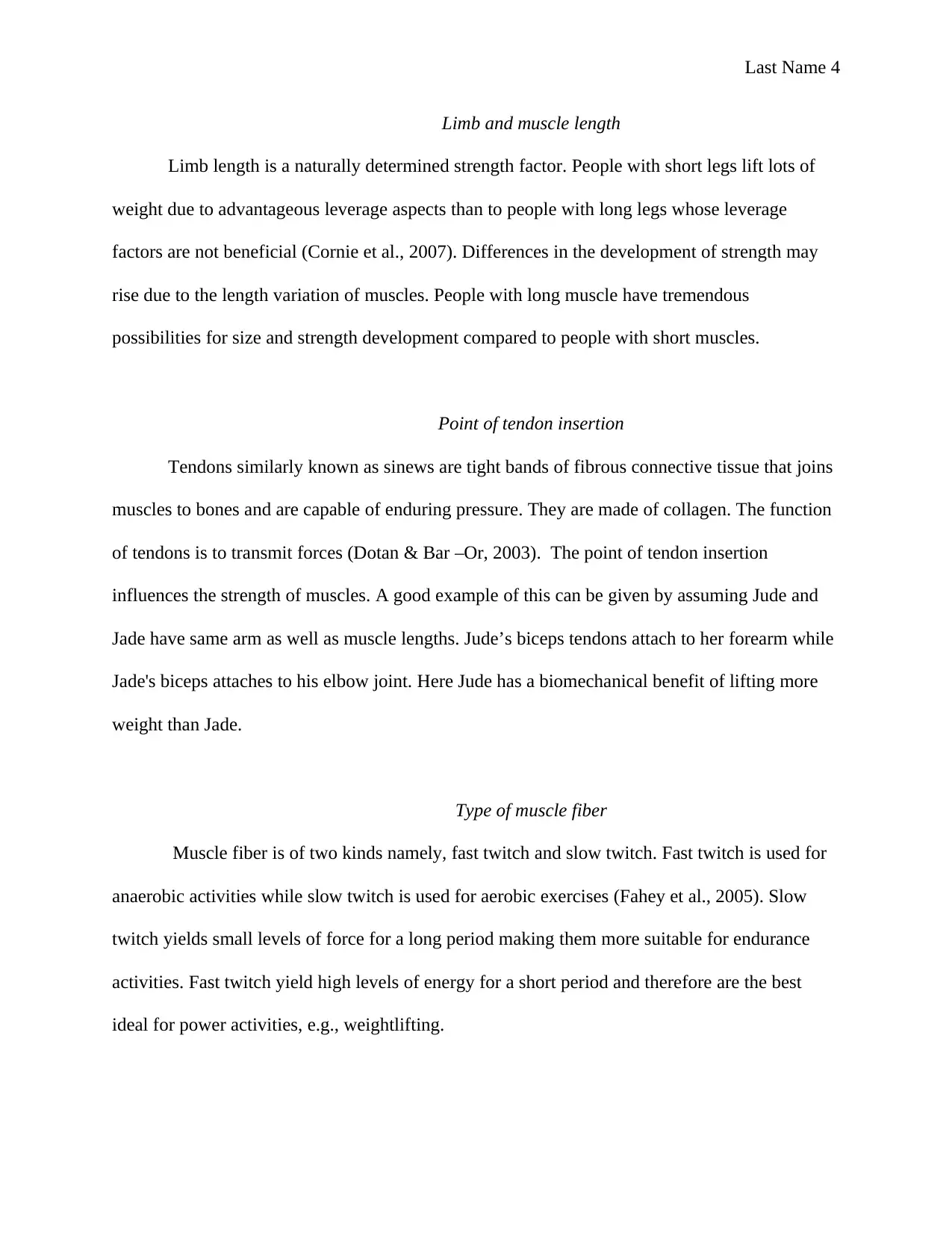
Last Name 4
Limb and muscle length
Limb length is a naturally determined strength factor. People with short legs lift lots of
weight due to advantageous leverage aspects than to people with long legs whose leverage
factors are not beneficial (Cornie et al., 2007). Differences in the development of strength may
rise due to the length variation of muscles. People with long muscle have tremendous
possibilities for size and strength development compared to people with short muscles.
Point of tendon insertion
Tendons similarly known as sinews are tight bands of fibrous connective tissue that joins
muscles to bones and are capable of enduring pressure. They are made of collagen. The function
of tendons is to transmit forces (Dotan & Bar –Or, 2003). The point of tendon insertion
influences the strength of muscles. A good example of this can be given by assuming Jude and
Jade have same arm as well as muscle lengths. Jude’s biceps tendons attach to her forearm while
Jade's biceps attaches to his elbow joint. Here Jude has a biomechanical benefit of lifting more
weight than Jade.
Type of muscle fiber
Muscle fiber is of two kinds namely, fast twitch and slow twitch. Fast twitch is used for
anaerobic activities while slow twitch is used for aerobic exercises (Fahey et al., 2005). Slow
twitch yields small levels of force for a long period making them more suitable for endurance
activities. Fast twitch yield high levels of energy for a short period and therefore are the best
ideal for power activities, e.g., weightlifting.
Limb and muscle length
Limb length is a naturally determined strength factor. People with short legs lift lots of
weight due to advantageous leverage aspects than to people with long legs whose leverage
factors are not beneficial (Cornie et al., 2007). Differences in the development of strength may
rise due to the length variation of muscles. People with long muscle have tremendous
possibilities for size and strength development compared to people with short muscles.
Point of tendon insertion
Tendons similarly known as sinews are tight bands of fibrous connective tissue that joins
muscles to bones and are capable of enduring pressure. They are made of collagen. The function
of tendons is to transmit forces (Dotan & Bar –Or, 2003). The point of tendon insertion
influences the strength of muscles. A good example of this can be given by assuming Jude and
Jade have same arm as well as muscle lengths. Jude’s biceps tendons attach to her forearm while
Jade's biceps attaches to his elbow joint. Here Jude has a biomechanical benefit of lifting more
weight than Jade.
Type of muscle fiber
Muscle fiber is of two kinds namely, fast twitch and slow twitch. Fast twitch is used for
anaerobic activities while slow twitch is used for aerobic exercises (Fahey et al., 2005). Slow
twitch yields small levels of force for a long period making them more suitable for endurance
activities. Fast twitch yield high levels of energy for a short period and therefore are the best
ideal for power activities, e.g., weightlifting.
Paraphrase This Document
Need a fresh take? Get an instant paraphrase of this document with our AI Paraphraser
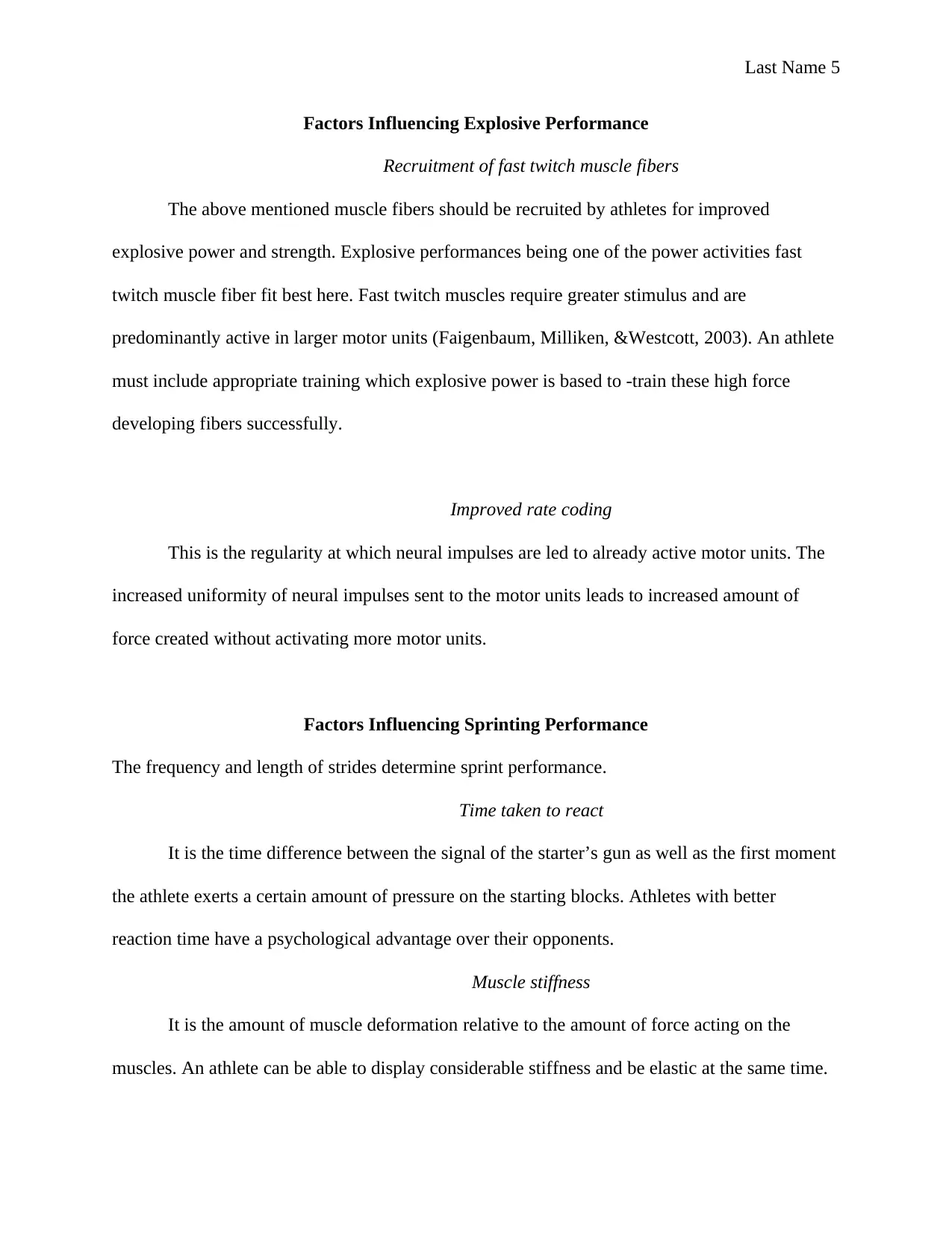
Last Name 5
Factors Influencing Explosive Performance
Recruitment of fast twitch muscle fibers
The above mentioned muscle fibers should be recruited by athletes for improved
explosive power and strength. Explosive performances being one of the power activities fast
twitch muscle fiber fit best here. Fast twitch muscles require greater stimulus and are
predominantly active in larger motor units (Faigenbaum, Milliken, &Westcott, 2003). An athlete
must include appropriate training which explosive power is based to -train these high force
developing fibers successfully.
Improved rate coding
This is the regularity at which neural impulses are led to already active motor units. The
increased uniformity of neural impulses sent to the motor units leads to increased amount of
force created without activating more motor units.
Factors Influencing Sprinting Performance
The frequency and length of strides determine sprint performance.
Time taken to react
It is the time difference between the signal of the starter’s gun as well as the first moment
the athlete exerts a certain amount of pressure on the starting blocks. Athletes with better
reaction time have a psychological advantage over their opponents.
Muscle stiffness
It is the amount of muscle deformation relative to the amount of force acting on the
muscles. An athlete can be able to display considerable stiffness and be elastic at the same time.
Factors Influencing Explosive Performance
Recruitment of fast twitch muscle fibers
The above mentioned muscle fibers should be recruited by athletes for improved
explosive power and strength. Explosive performances being one of the power activities fast
twitch muscle fiber fit best here. Fast twitch muscles require greater stimulus and are
predominantly active in larger motor units (Faigenbaum, Milliken, &Westcott, 2003). An athlete
must include appropriate training which explosive power is based to -train these high force
developing fibers successfully.
Improved rate coding
This is the regularity at which neural impulses are led to already active motor units. The
increased uniformity of neural impulses sent to the motor units leads to increased amount of
force created without activating more motor units.
Factors Influencing Sprinting Performance
The frequency and length of strides determine sprint performance.
Time taken to react
It is the time difference between the signal of the starter’s gun as well as the first moment
the athlete exerts a certain amount of pressure on the starting blocks. Athletes with better
reaction time have a psychological advantage over their opponents.
Muscle stiffness
It is the amount of muscle deformation relative to the amount of force acting on the
muscles. An athlete can be able to display considerable stiffness and be elastic at the same time.
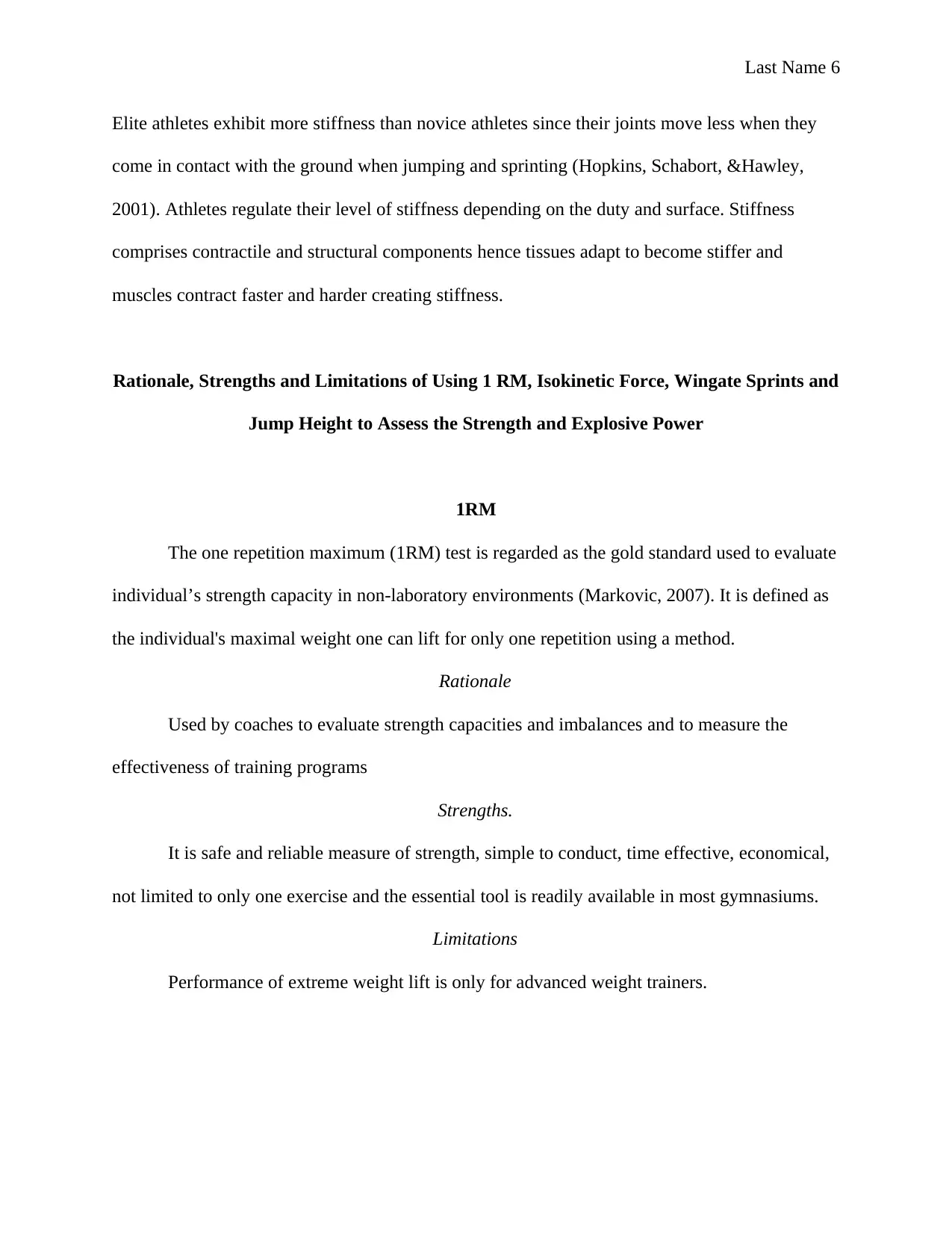
Last Name 6
Elite athletes exhibit more stiffness than novice athletes since their joints move less when they
come in contact with the ground when jumping and sprinting (Hopkins, Schabort, &Hawley,
2001). Athletes regulate their level of stiffness depending on the duty and surface. Stiffness
comprises contractile and structural components hence tissues adapt to become stiffer and
muscles contract faster and harder creating stiffness.
Rationale, Strengths and Limitations of Using 1 RM, Isokinetic Force, Wingate Sprints and
Jump Height to Assess the Strength and Explosive Power
1RM
The one repetition maximum (1RM) test is regarded as the gold standard used to evaluate
individual’s strength capacity in non-laboratory environments (Markovic, 2007). It is defined as
the individual's maximal weight one can lift for only one repetition using a method.
Rationale
Used by coaches to evaluate strength capacities and imbalances and to measure the
effectiveness of training programs
Strengths.
It is safe and reliable measure of strength, simple to conduct, time effective, economical,
not limited to only one exercise and the essential tool is readily available in most gymnasiums.
Limitations
Performance of extreme weight lift is only for advanced weight trainers.
Elite athletes exhibit more stiffness than novice athletes since their joints move less when they
come in contact with the ground when jumping and sprinting (Hopkins, Schabort, &Hawley,
2001). Athletes regulate their level of stiffness depending on the duty and surface. Stiffness
comprises contractile and structural components hence tissues adapt to become stiffer and
muscles contract faster and harder creating stiffness.
Rationale, Strengths and Limitations of Using 1 RM, Isokinetic Force, Wingate Sprints and
Jump Height to Assess the Strength and Explosive Power
1RM
The one repetition maximum (1RM) test is regarded as the gold standard used to evaluate
individual’s strength capacity in non-laboratory environments (Markovic, 2007). It is defined as
the individual's maximal weight one can lift for only one repetition using a method.
Rationale
Used by coaches to evaluate strength capacities and imbalances and to measure the
effectiveness of training programs
Strengths.
It is safe and reliable measure of strength, simple to conduct, time effective, economical,
not limited to only one exercise and the essential tool is readily available in most gymnasiums.
Limitations
Performance of extreme weight lift is only for advanced weight trainers.
⊘ This is a preview!⊘
Do you want full access?
Subscribe today to unlock all pages.

Trusted by 1+ million students worldwide
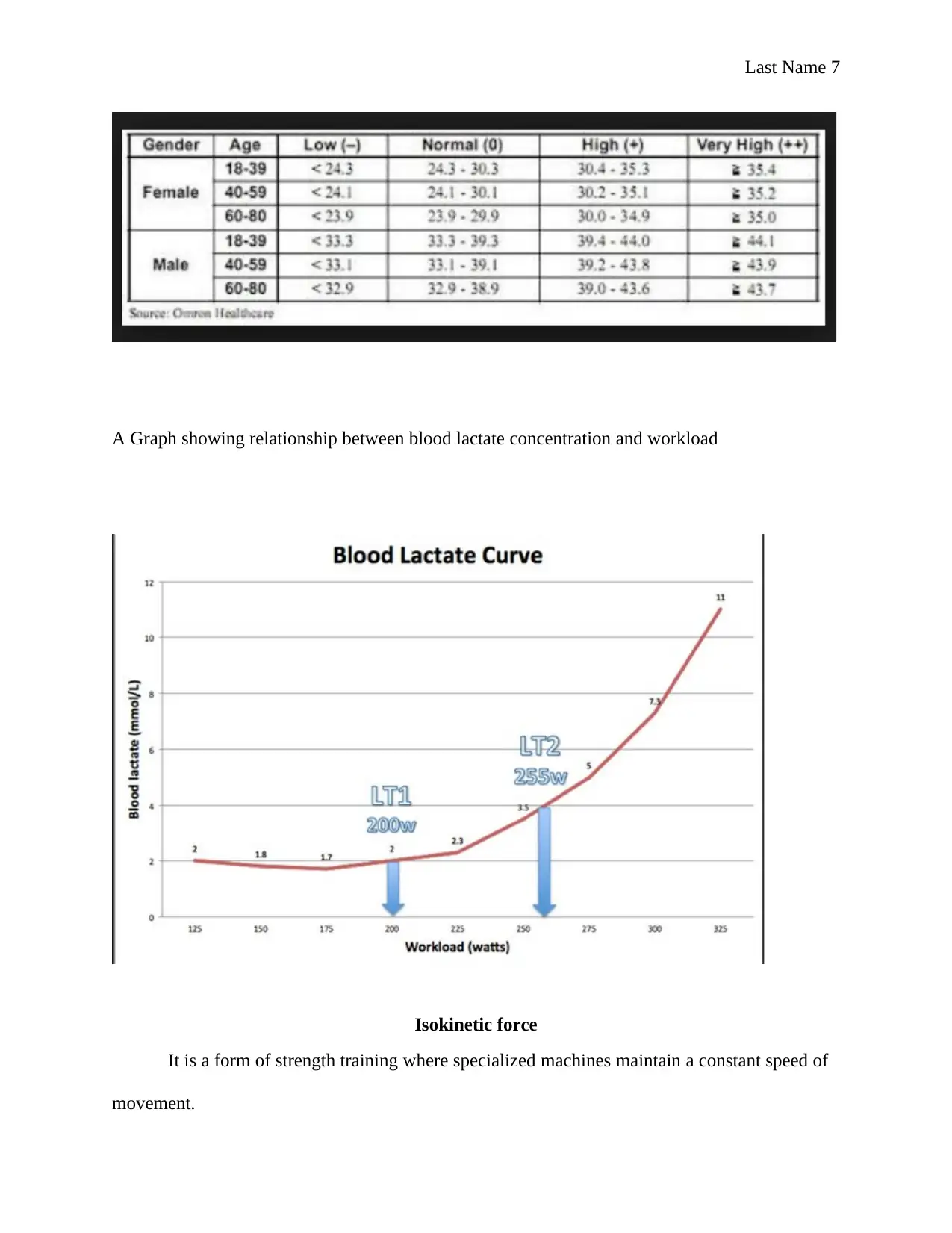
Last Name 7
A Graph showing relationship between blood lactate concentration and workload
Isokinetic force
It is a form of strength training where specialized machines maintain a constant speed of
movement.
A Graph showing relationship between blood lactate concentration and workload
Isokinetic force
It is a form of strength training where specialized machines maintain a constant speed of
movement.
Paraphrase This Document
Need a fresh take? Get an instant paraphrase of this document with our AI Paraphraser
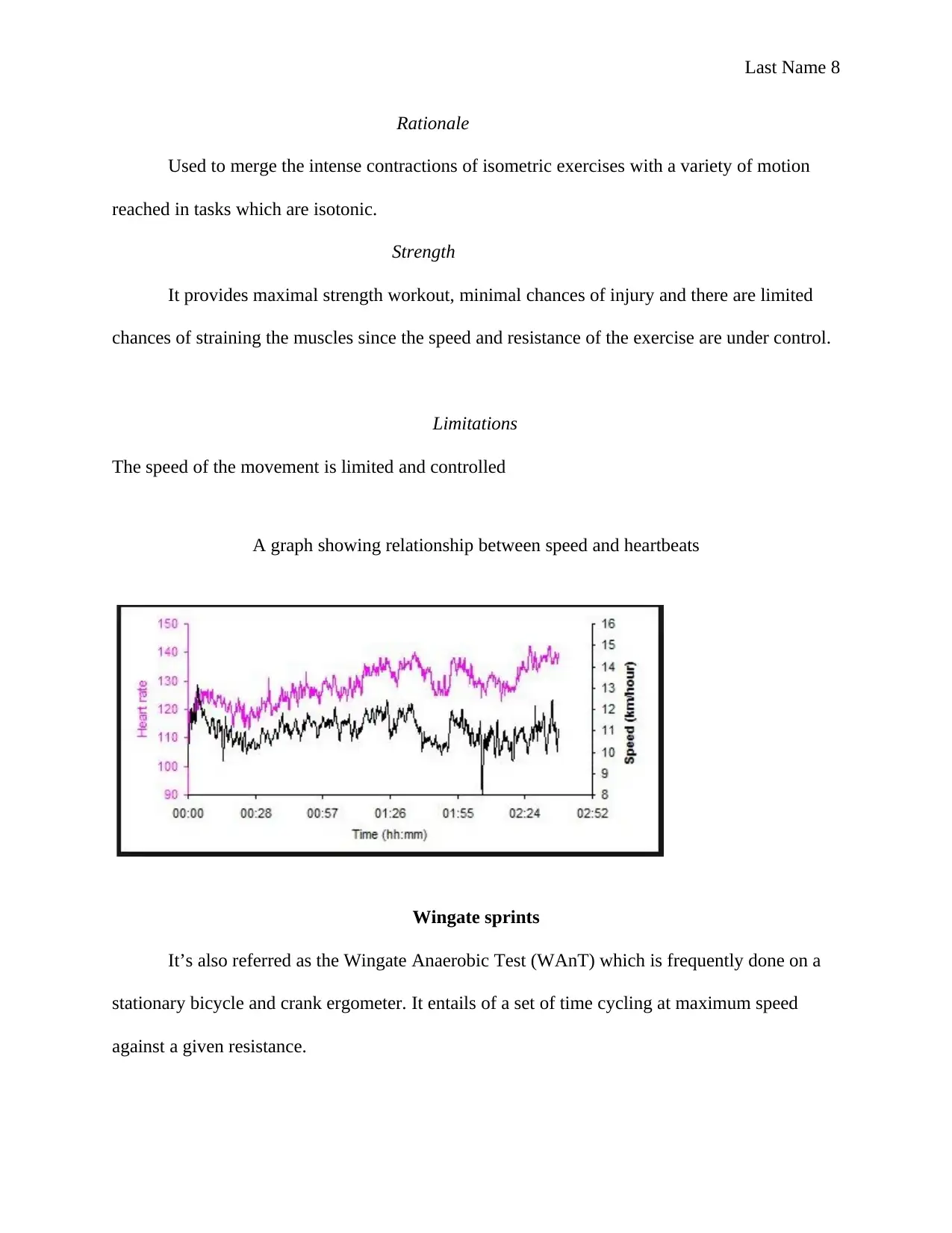
Last Name 8
Rationale
Used to merge the intense contractions of isometric exercises with a variety of motion
reached in tasks which are isotonic.
Strength
It provides maximal strength workout, minimal chances of injury and there are limited
chances of straining the muscles since the speed and resistance of the exercise are under control.
Limitations
The speed of the movement is limited and controlled
A graph showing relationship between speed and heartbeats
Wingate sprints
It’s also referred as the Wingate Anaerobic Test (WAnT) which is frequently done on a
stationary bicycle and crank ergometer. It entails of a set of time cycling at maximum speed
against a given resistance.
Rationale
Used to merge the intense contractions of isometric exercises with a variety of motion
reached in tasks which are isotonic.
Strength
It provides maximal strength workout, minimal chances of injury and there are limited
chances of straining the muscles since the speed and resistance of the exercise are under control.
Limitations
The speed of the movement is limited and controlled
A graph showing relationship between speed and heartbeats
Wingate sprints
It’s also referred as the Wingate Anaerobic Test (WAnT) which is frequently done on a
stationary bicycle and crank ergometer. It entails of a set of time cycling at maximum speed
against a given resistance.
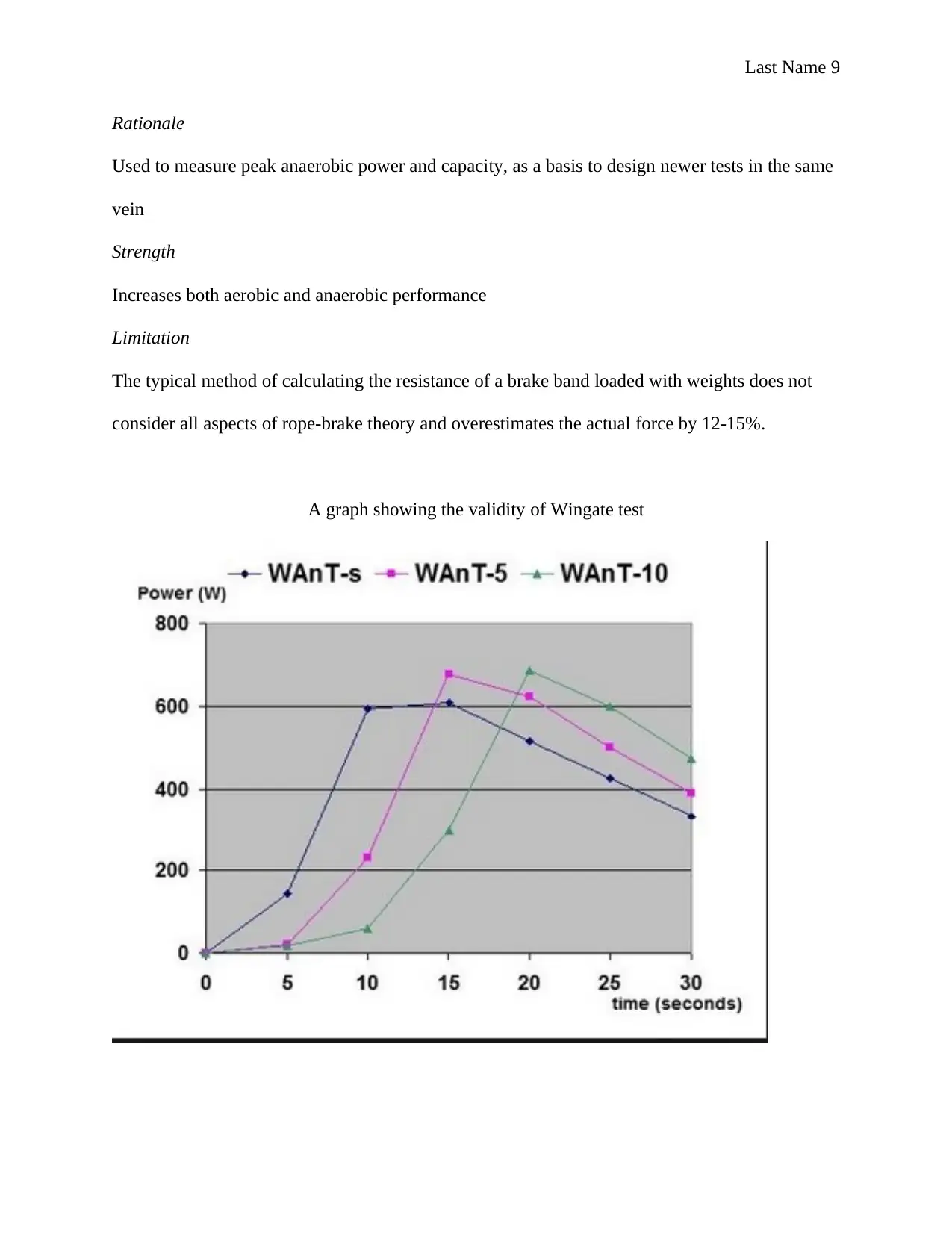
Last Name 9
Rationale
Used to measure peak anaerobic power and capacity, as a basis to design newer tests in the same
vein
Strength
Increases both aerobic and anaerobic performance
Limitation
The typical method of calculating the resistance of a brake band loaded with weights does not
consider all aspects of rope-brake theory and overestimates the actual force by 12-15%.
A graph showing the validity of Wingate test
Rationale
Used to measure peak anaerobic power and capacity, as a basis to design newer tests in the same
vein
Strength
Increases both aerobic and anaerobic performance
Limitation
The typical method of calculating the resistance of a brake band loaded with weights does not
consider all aspects of rope-brake theory and overestimates the actual force by 12-15%.
A graph showing the validity of Wingate test
⊘ This is a preview!⊘
Do you want full access?
Subscribe today to unlock all pages.

Trusted by 1+ million students worldwide
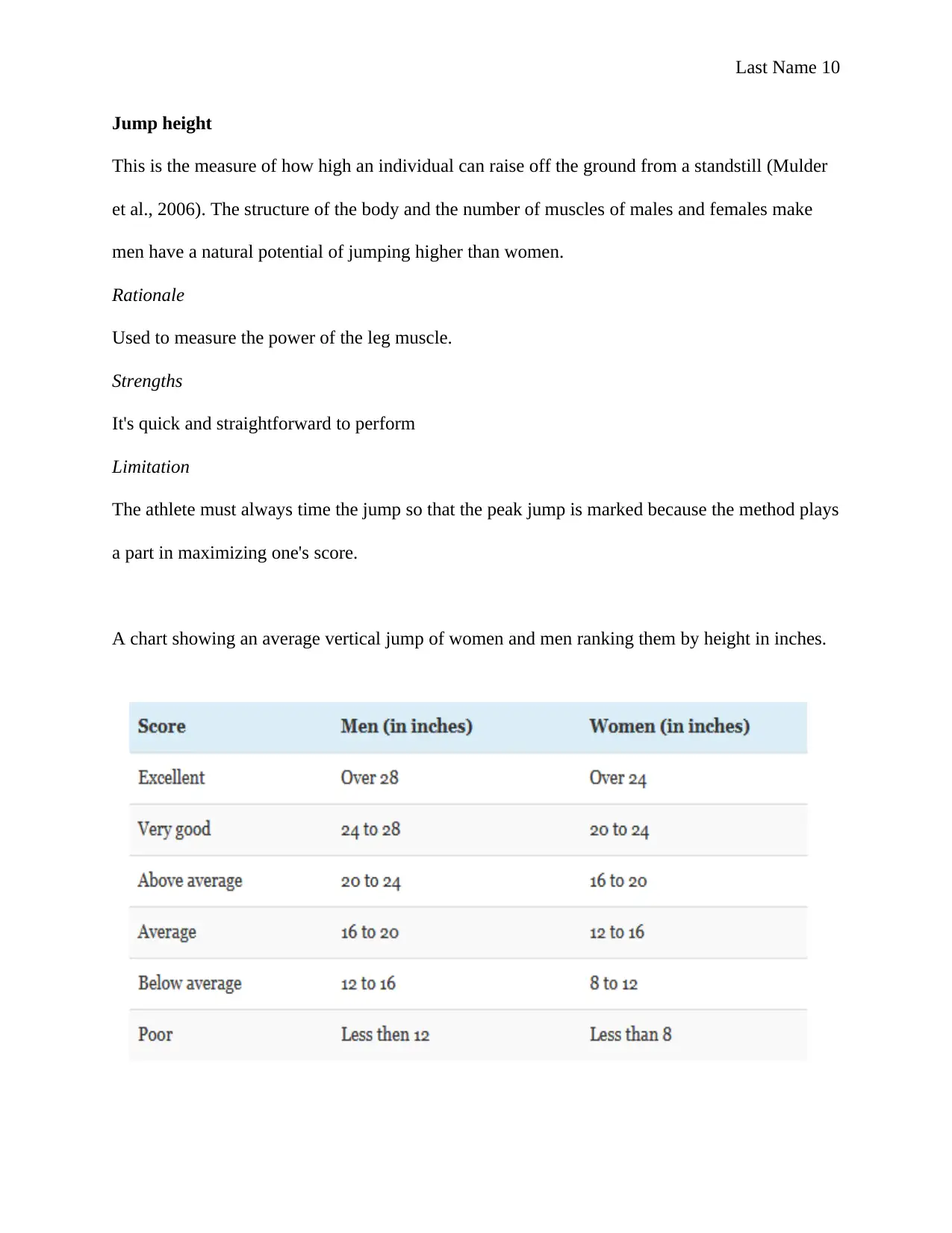
Last Name 10
Jump height
This is the measure of how high an individual can raise off the ground from a standstill (Mulder
et al., 2006). The structure of the body and the number of muscles of males and females make
men have a natural potential of jumping higher than women.
Rationale
Used to measure the power of the leg muscle.
Strengths
It's quick and straightforward to perform
Limitation
The athlete must always time the jump so that the peak jump is marked because the method plays
a part in maximizing one's score.
A chart showing an average vertical jump of women and men ranking them by height in inches.
Jump height
This is the measure of how high an individual can raise off the ground from a standstill (Mulder
et al., 2006). The structure of the body and the number of muscles of males and females make
men have a natural potential of jumping higher than women.
Rationale
Used to measure the power of the leg muscle.
Strengths
It's quick and straightforward to perform
Limitation
The athlete must always time the jump so that the peak jump is marked because the method plays
a part in maximizing one's score.
A chart showing an average vertical jump of women and men ranking them by height in inches.
Paraphrase This Document
Need a fresh take? Get an instant paraphrase of this document with our AI Paraphraser
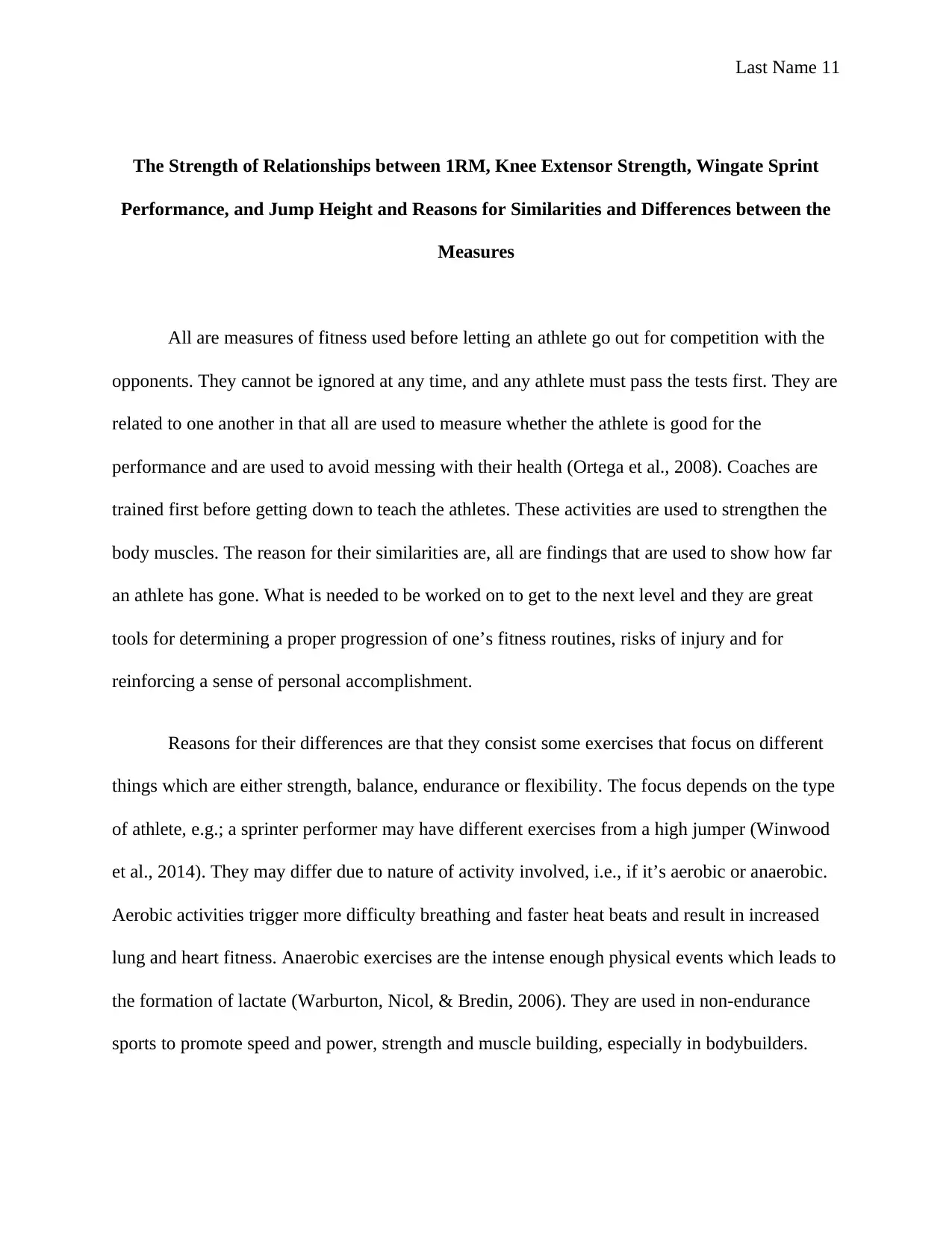
Last Name 11
The Strength of Relationships between 1RM, Knee Extensor Strength, Wingate Sprint
Performance, and Jump Height and Reasons for Similarities and Differences between the
Measures
All are measures of fitness used before letting an athlete go out for competition with the
opponents. They cannot be ignored at any time, and any athlete must pass the tests first. They are
related to one another in that all are used to measure whether the athlete is good for the
performance and are used to avoid messing with their health (Ortega et al., 2008). Coaches are
trained first before getting down to teach the athletes. These activities are used to strengthen the
body muscles. The reason for their similarities are, all are findings that are used to show how far
an athlete has gone. What is needed to be worked on to get to the next level and they are great
tools for determining a proper progression of one’s fitness routines, risks of injury and for
reinforcing a sense of personal accomplishment.
Reasons for their differences are that they consist some exercises that focus on different
things which are either strength, balance, endurance or flexibility. The focus depends on the type
of athlete, e.g.; a sprinter performer may have different exercises from a high jumper (Winwood
et al., 2014). They may differ due to nature of activity involved, i.e., if it’s aerobic or anaerobic.
Aerobic activities trigger more difficulty breathing and faster heat beats and result in increased
lung and heart fitness. Anaerobic exercises are the intense enough physical events which leads to
the formation of lactate (Warburton, Nicol, & Bredin, 2006). They are used in non-endurance
sports to promote speed and power, strength and muscle building, especially in bodybuilders.
The Strength of Relationships between 1RM, Knee Extensor Strength, Wingate Sprint
Performance, and Jump Height and Reasons for Similarities and Differences between the
Measures
All are measures of fitness used before letting an athlete go out for competition with the
opponents. They cannot be ignored at any time, and any athlete must pass the tests first. They are
related to one another in that all are used to measure whether the athlete is good for the
performance and are used to avoid messing with their health (Ortega et al., 2008). Coaches are
trained first before getting down to teach the athletes. These activities are used to strengthen the
body muscles. The reason for their similarities are, all are findings that are used to show how far
an athlete has gone. What is needed to be worked on to get to the next level and they are great
tools for determining a proper progression of one’s fitness routines, risks of injury and for
reinforcing a sense of personal accomplishment.
Reasons for their differences are that they consist some exercises that focus on different
things which are either strength, balance, endurance or flexibility. The focus depends on the type
of athlete, e.g.; a sprinter performer may have different exercises from a high jumper (Winwood
et al., 2014). They may differ due to nature of activity involved, i.e., if it’s aerobic or anaerobic.
Aerobic activities trigger more difficulty breathing and faster heat beats and result in increased
lung and heart fitness. Anaerobic exercises are the intense enough physical events which leads to
the formation of lactate (Warburton, Nicol, & Bredin, 2006). They are used in non-endurance
sports to promote speed and power, strength and muscle building, especially in bodybuilders.
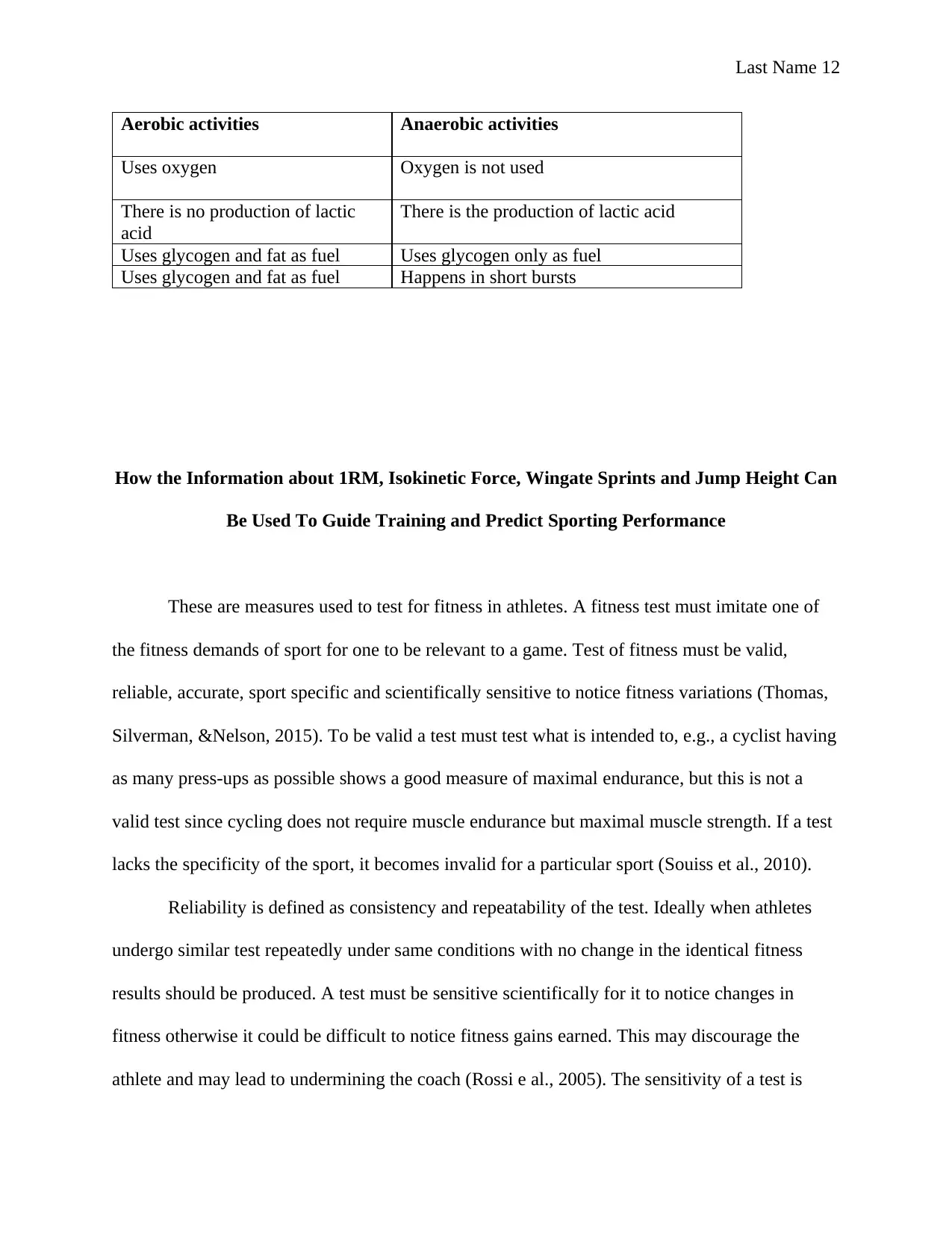
Last Name 12
Aerobic activities Anaerobic activities
Uses oxygen Oxygen is not used
There is no production of lactic
acid
There is the production of lactic acid
Uses glycogen and fat as fuel Uses glycogen only as fuel
Uses glycogen and fat as fuel Happens in short bursts
How the Information about 1RM, Isokinetic Force, Wingate Sprints and Jump Height Can
Be Used To Guide Training and Predict Sporting Performance
These are measures used to test for fitness in athletes. A fitness test must imitate one of
the fitness demands of sport for one to be relevant to a game. Test of fitness must be valid,
reliable, accurate, sport specific and scientifically sensitive to notice fitness variations (Thomas,
Silverman, &Nelson, 2015). To be valid a test must test what is intended to, e.g., a cyclist having
as many press-ups as possible shows a good measure of maximal endurance, but this is not a
valid test since cycling does not require muscle endurance but maximal muscle strength. If a test
lacks the specificity of the sport, it becomes invalid for a particular sport (Souiss et al., 2010).
Reliability is defined as consistency and repeatability of the test. Ideally when athletes
undergo similar test repeatedly under same conditions with no change in the identical fitness
results should be produced. A test must be sensitive scientifically for it to notice changes in
fitness otherwise it could be difficult to notice fitness gains earned. This may discourage the
athlete and may lead to undermining the coach (Rossi e al., 2005). The sensitivity of a test is
Aerobic activities Anaerobic activities
Uses oxygen Oxygen is not used
There is no production of lactic
acid
There is the production of lactic acid
Uses glycogen and fat as fuel Uses glycogen only as fuel
Uses glycogen and fat as fuel Happens in short bursts
How the Information about 1RM, Isokinetic Force, Wingate Sprints and Jump Height Can
Be Used To Guide Training and Predict Sporting Performance
These are measures used to test for fitness in athletes. A fitness test must imitate one of
the fitness demands of sport for one to be relevant to a game. Test of fitness must be valid,
reliable, accurate, sport specific and scientifically sensitive to notice fitness variations (Thomas,
Silverman, &Nelson, 2015). To be valid a test must test what is intended to, e.g., a cyclist having
as many press-ups as possible shows a good measure of maximal endurance, but this is not a
valid test since cycling does not require muscle endurance but maximal muscle strength. If a test
lacks the specificity of the sport, it becomes invalid for a particular sport (Souiss et al., 2010).
Reliability is defined as consistency and repeatability of the test. Ideally when athletes
undergo similar test repeatedly under same conditions with no change in the identical fitness
results should be produced. A test must be sensitive scientifically for it to notice changes in
fitness otherwise it could be difficult to notice fitness gains earned. This may discourage the
athlete and may lead to undermining the coach (Rossi e al., 2005). The sensitivity of a test is
⊘ This is a preview!⊘
Do you want full access?
Subscribe today to unlock all pages.

Trusted by 1+ million students worldwide
1 out of 16
Your All-in-One AI-Powered Toolkit for Academic Success.
+13062052269
info@desklib.com
Available 24*7 on WhatsApp / Email
![[object Object]](/_next/static/media/star-bottom.7253800d.svg)
Unlock your academic potential
Copyright © 2020–2025 A2Z Services. All Rights Reserved. Developed and managed by ZUCOL.
